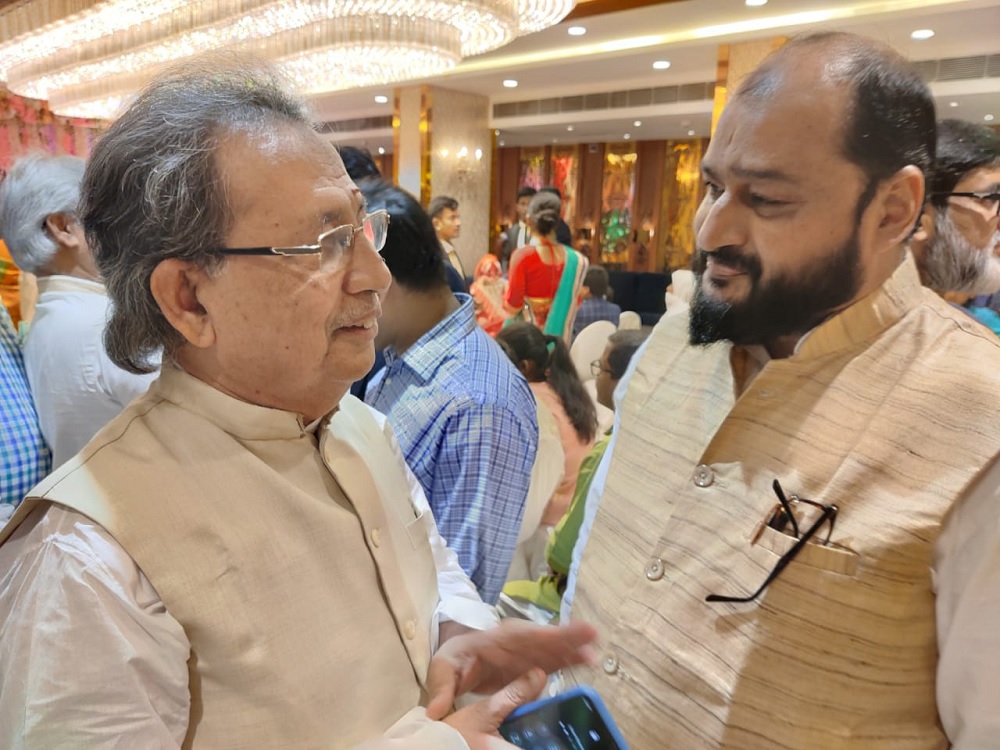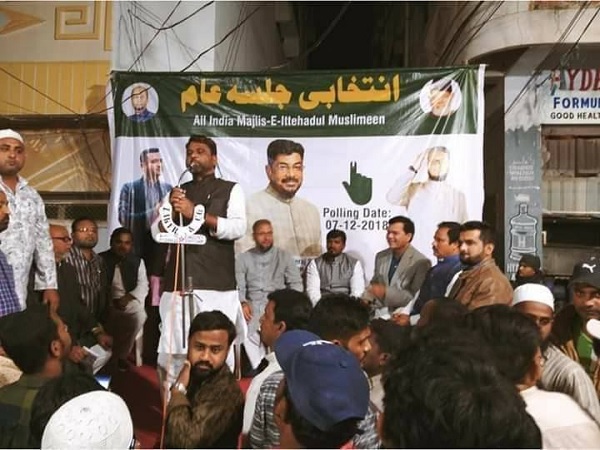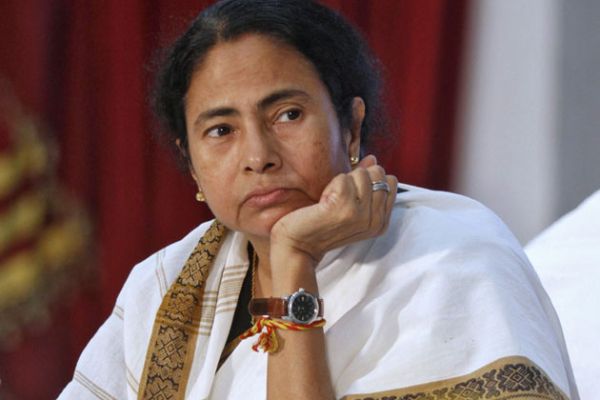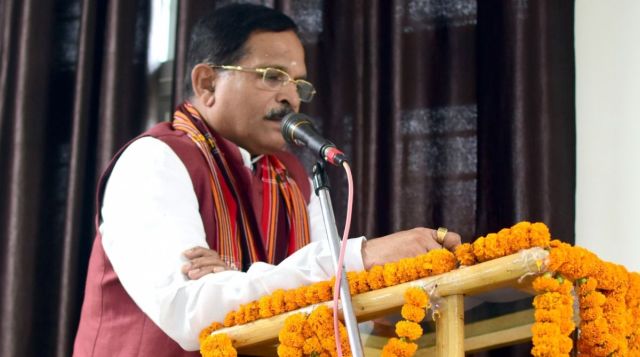
by Editor | Jan 11, 2022 | Interviews
The otherwise poor and rudderless Muslim community in West Bengal is awakened now and raring to succeed thanks to the Howrah-based Al Ameen Mission, anchoring an educational renaissance in the state. Danish Reyaz speaks to its Founder-General Secretary M.Nurul Islam about Mission’s journey, vision, and impact on Bengali Muslims.
Al-Ameen Mission has strived to educate the community from its very beginning, how far has it been successful in this mission?
Al-Ameen Mission began its journey in 1986. When it started its journey with only eleven students in a remote village, the overall education scenario of the Muslim community in West Bengal was quite dismal. There were various reasons- historical, social and economic as well. We realised that we should strive to educate the community, as you rightly mentioned, for the betterment of it. Frankly speaking, with the grace of Allah, we have been successful in this endeavour. There were many ups and downs in our journey. But we had never stopped. So far, we could say we are successful in our mission. We have scores of doctors, engineers, professors, teachers, civil servants, entrepreneurs. Our boys and girls are working throughout the country and have also established themselves abroad. I can say in a nutshell that we have infused new blood in an otherwise moribund society, which had seen for more than three decades post independence.
West Bengal is considered to be a backward area from the time of independence, but the backwardness of Muslims has increased further, what are the reasons for this?
The reasons are not difficult to find out, you know. We have to bear in mind that India was partitioned during independence of the country back in 1947. Muslims, not all, of course, went to East Pakistan during that period. The problem was that the intelligentsia went away as the fallout of partition. Those who remained here were confined mainly in the rural areas. Most of them were small farmers. Many went for blue collar jobs. Lack of education made the whole community to remain stagnant. What we did was to plant a seed of education which has eventually turned into a gigantic tree.
Al-Ameen Mission has educated thousands of children, how it has been successful in making an impact?
As I have already mentioned, we have gradually been able to turn the table. When we started our journey 35 years ago, the percentage of Muslim students in Medical as well as in Engineering was only 2% or 3%. But due to our endeavour mainly that percentage has risen to 20 to 30%. It has imbibed confidence. Boys and girls mostly from backward areas and lowest strata of the society are now dreaming to becoming doctors, engineers, civil servants, scientists, teachers, professors and some have even ventured into being entrepreneurs. Obviously, a silent revolution is taking place.
Al-Ameen Mission is establishing a new campus in New Town, how it realized the need for this?
Yes, a project is under construction in the New Town. We have a 2 acre of land there. It will be called Al-Ameen Mission Institute for Education Research and Training. It would provide residential coaching for Civil Services, NEET (UG & PG), JEE-IIT and IIM aspirants. It will also cater training to teachers and administrative staffs of various academic institutions. The Research scholars would be provided accommodation and research facilities under one roof.
What is the future plan of Al-Ameen Mission?
Our work on the education sector would continue. But we are also venturing into health sector in a big way.
Does Al-Ameen Mission have a plan for entrepreneurship development?
Al-Ameen Mission has become an embodiment of social entrepreneurship. We’re a family of 20 thousand members- 17 thousand resident students and three thousand teachers and non teaching staff. Churning out resources- financial, human as well as intellectual- from within a backward society, a new awakening is taking place slowly, steering it towards a livelier and better society. An educated, middle class society is fast emerging; thousands of people getting employed. Please remember, this gigantic activism is taking place not through a family or solo enterprise but through social entrepreneurship. There is no foreign funding; government help is also negligible, so to say. Corporate funding is nil. Fees from students-those who are better off would pay more fees, those who can’t provide much would pay nominal fees, and those from poor families would pay half the fees- plus Zakat and donation from a wide array of persons from all walks of the society has been instrumental for Al-Ameen Mission to flourish.
Any type of entrepreneurship involves risks and problems; hurdles and hostilities. But good intention and faith in Allah would turn all these negativities into Allah’s mercy and blessings. We have literally perceived this throughout our journey.
Our Prophet Mohammad (SAW) was himself a successful entrepreneur. Naturally, for us, business enterprise, by all means, is a Sunnah. For a society or for that matter a country to prosper, the role of an entrepreneur is vitally important. Therefore, we are encouraging students to become entrepreneurs besides other employment opportunities.

by admin | May 25, 2021 | News, Opinions

MIM chief Asaduddin Owaisi at a election rally in Bihar
Wooing away Muslims from Mamata Banerjee’s Trinamool Congress is no easy job. The Muslims of West Bengal have learnt a lesson from Bihar experience
By Soroor Ahmed | Patna
OF the five states going to poll in April-May West Bengal, Assam and Kerala have substantial Muslim populations. In fact, in Assam where the Bharatiya Janata Party is in power, almost one-third of the population is Muslim.
Yet the All India Majlis-e-Ittehad-ul-Muslimeen’s chief, Asaduddin Owaisi, has not disclosed any plan to fight election in Assam and Kerala, which along with Tamil Nadu and Puducherry are going to polls in the summer.
Till now he has focussed only on West Bengal. On January 3, Owaisi met a ‘spiritual’ personality of Furfura Shareef in Hooghly district of West Bengal, Abbas Siddiqui, with a view to contesting Assembly election in the state.
It can be argued that the presence of the All India United Democratic Front of Badruddin Ajmal in Assam and Indian Union Muslim League in Kerala may have compelled him from not throwing the hat in the ring in these two states. But in Bihar, AIMIM did not shy away from the contest even as the Popular Front of India, essentially a Muslim outfit, was in the fray.
While AIMIM joined hands in the recently held election in Bihar with Bahujan Samaj Party and former Union minister Upendra Kushwaha’s Rashtriya Lok Samata Party, the PFI formed an alliance with former MP Rajesh Ranjan, alias Pappu Yadav’s Jan Adhikar Party.
Except AIMIM and BSP, which won five and one seat respectively, the rest three failed to open their account. All the five who won on the AIMIM tickets, had their association with either the Congress or RJD in the past.
By Owaisi’s own logic the first priority should be to wage a big battle against the Indian Union Muslim League because it is in alliance with the same secular Congress, whom the Hyderabad MP blames for all the ills plaguing Muslims of India. It is other thing that AIMIM only broke the two decades long relationship with the Congress in Andhra Pradesh in 2012, that is after the resurgence of the BJP across India.
It remained a mystery as to why Asaduddin Owaisi is not exposing IUML when he is quick to blame former PM Rajiv Gandhi, former UP and Bihar CMs Akhilesh Yadav and Lalu Prasad respectively and the present West Bengal Chief Minister Mamata Banerjee. Is it not a fact that AIMIM chief’s late father Salahuddin Owaisi, former MP from Hyderabad, once had good relationship with Rajiv Gandhi?
Should it be understood that AIMIM’s chief is not poking his nose in Kerala as the BJP would not be benefited there as it is too weak.
In the same way it would be perhaps a futile exercise to plunge into the complicated politics of Assam where the BJP is already in power.
The AIMIM has every right to contest from anywhere in India. At the same time citizens of the country have full right—if it is so possible—to ask him why is it that he is so selective in choosing the states and constituencies to fight elections? In his own state, Telangana, the AIMIM hardly goes out of Greater Hyderabad. If Akhilesh, Mamata, Lalu or his son Tejashwi are so bad for Muslims how good K Chandrashekar Rao is for the community in Telangana where his party is in alliance with the ruling Telangana Rashtriya Samiti.
Perhaps Owaisi might have been a more respectable politician had he been honest in approach and quite open in support of the BJP. Secretly supporting the BJP is, in the long run, going to harm his own brand of politics. After all Owaisi should be aware of the fact that the Telangana Chief Minister K Chandrashekar Rao is thinking in terms of dissociating himself from the AIMIM after the very good performance of the saffron party in Greater Hyderabad Municipal Corporation election last month. The BJP’s tally jumped from four to 48 while the TRS got reduced to 56 from 99 in the 150 wards civic body. The AIMIM managed to retain 44 seats as it contested only in 51.
Owaisi should look into his own future as the BJP has performed better than AIMIM in Hyderabad itself. If the trend continues and the TRS abandons Owaisi the AIMIM may be reduced to 1994 Assembly election like situation in which it could win only one seat as the Telugu Desam Party of N.T. Rama Rao swept the polls winning 216 seats.
If Owaisi is encouraged by the result of Bihar election he is somewhat overrating himself as there is a crucial factor which many political pundits had overlooked. That was the presence of a full-fledged politician in the state unit of AIMIM. Akhtar-ul-Iman, the Bihar unit president, had been two-time RJD MLA from Kishanganj district and is the tallest leader of the Surjapuri Muslims. Besides Akhtar, the other four MLAs who won are no novice politicians. One of them, Shahnawaz Alam, is the son of late RJD stalwart and former Union minister, Mohammad Taslimuddin. Shahnawaz himself was a RJD MLA but at the time of distribution of ticket Tejashwi Yadav preferred his elder brother and former MP Sarfaraz Alam. In the contest between the two brothers Shahnawaz won. Owaisi has taken all the credits for AIMIM’s performance when the ground reality was something else. Apart from this the first AIMIM’s victory came in October 2019 by-election four years after it set its foot in Bihar.
In contrast Abbas Siddiqi in Bengal has no political experience. Reports coming from Bengal say that he may float his own party as he nurses political ambition. Owaisi himself is not sure whether Siddiqi will join hands with him or not. Not only that, wooing away Muslims from Mamata Banerjee’s Trinamool Congress is no easy job. The Muslims of West Bengal have learnt a lesson from Bihar experience.

by admin | May 25, 2021 | Opinions

Soroor Ahmed
By Soroor Ahmed | Patna
The constant bombardments of narrative of Muslim backwardness with the help of half-baked figures only lead to despondency and hopelessness among the community, especially its youth. Instead the community leaders should objectively discuss each and every aspect–even its positive achievements, for example, West Bengal, Kerala and Kashmir have done exceptionally well in the last few years. Be it in the medical and engineering entrance examinations or any other field.
“There are three types of lies–lies, damn lies, and statistics,” said former British Prime Minister Benjamin Disraeli.
“Facts are stubborn things, but statistics are pliable,” said American English writer Mark Twain.
Yet the importance of statistics cannot be under-estimated in this modern world. We now have a subject called Statistics.
Though the government data and statistics give some idea about development or backwardness of any state, country, community etc. yet very often such figures are misleading, if not lies. They are half-truths and sometimes should be taken with a pinch of salt.
But it seems that Indian Muslims have an obsession for data and statistic. They love to be dubbed as backward. So wherever the Muslim leaders see any study or research work which highlight their backwardness they simply embrace them. Without independently examining and analysing the data the campaign starts to spread its conclusion of such surveys. The self-proclaimed leading lights of the community have been doing this with the help of the Sachar Committee report for the last 14 years. In the process the community leaders have tried to convince the masses that the only sentence written in this 400-odd pages report is “Muslims lag behind Dalits in all walks of life”.
The truth is that the Sachar Committee report is a study done on the status of Muslims in India and in the process it has made comparison with several social groups of the country. It based its report on the data of 2001 Census, NSSO etc. and has not done its own first-hand survey. The figures given in the government surveys may not be hundred per cent correct.
Before the Sachar a similar study was done by Gopal Singh report, but it could not be quoted too much as that was the period of less media publicity.
No doubt the Sachar report said that in some social, economic and educational indicators Muslims lag behind Dalits, but in some they are ahead of them or are on par with the Other Backward Castes, or may be even ahead of them. Yet in some areas Muslims are even ahead of general Hindus. But no one in our seminars or conference is going to highlight the last fact.
For example, in health sector, notwithstanding the government neglect of the community the child mortality rate and infant mortality rate among Muslims are much less than even general category Hindus. The maternal mortality rate among Muslims is less than Hindus even though Muslim women give more birth than their Hindu sisters.
Besides, on an average the life-span of Muslims is one year more than Hindus. These are just a few positive examples cited in the Sachar Committee report yet they hardly find mention in any public discourse for some unknown reasons.
As if that was not enough the community has now discovered in Christophe Jaffrelot another talent. No doubt he is a regular contributor to various journals and newspapers, for example, the Indian Express. Yet, it remained a mystery as to what prompted Bengali Academy for Social Empowerment to organise a webinar on August 8 on the condition of Muslims at the height of Corona Virus. Not only that some community portals even highlighted in great detail whatever Jaffrelot had tried to explain, in this long webinar which once again was largely based on the same Sachar Committee report and similar data. Is it that Muslims are not aware of them?
What needs to be told loud and clear that such non-stop exercises are not only futile but counter-productive as well. The constant bombardments with the help of half-baked figures only lead to despondency and hopelessness among the community, especially its youth. Instead the community leaders should objectively discuss each and every aspect–even its positive achievements, for example, West Bengal, Kerala and Kashmir have done exceptionally well in the last few years. Be it in the medical and engineering entrance examinations or any other field. In civil services examinations the youths of Kashmir, including girls, have been doing remarkably better, more by efforts of the community and less by government policy or action.
Take the example of Kishanganj district of Bihar, about which another prophet of doom, Asaduddin Owaisi of AIMIM, always makes so much hue and cry. What this gentleman does not know, or wants to deliberately hide, is that this district of north-east Bihar had witnessed fastest growth in literacy rate in India between 2001 and 2011–especially in the women’s literacy.
The tragedy is that most of the time the community relies on the lecture by some western social scientists to understand our problem. What the community leaders failed to realize is that any such research can be done by the scholars from within the country who have much larger personal experience of the social, economic and educational milieu. There is nothing like rocket science involved in it.
The compilation of old figures and data would lead to nowhere as the situation keeps changing constantly. Besides it should be also researched as to how the community is not only surviving but even doing better than the upper caste Hindus in some indicators. Very little has been written as to how remittance money has played an important role in keeping the community alive. After all remittance-earning among the Muslims is disproportionately higher.
The absurd way of drawing parallel between Muslims and Dalits should be immediately stopped. One should not be selective in quoting figures to establish that Muslims lag behind Scheduled Castes and Tribes. The truth can be known when Muslim social scientists, researchers or journalists give equal time in the Dalit as well as their own inhabitants. Just make a survey of as to how many SC/STs and Muslims own CBSE schools, apartments, hotels, restaurants, marketing complexes in any city of India. No doubt Muslims may be no match to upper castes or may be even OBCs, but their number would certainly be many times more than SCs or STs.
At the lowest level, just collect a data on the figures of those dying of starvation, committing suicide due to hunger or compelled to eat rats and roots in the jungles of east and central India. One would soon know the fact as to how bad the SCs and STs are doing.
What the Muslim researchers often do is they take up only the localities and villages dominated by their own community and come to faulty conclusion. They do not dare to spend a few nights in the hutments of Valmikis, Musahars, even Ravidas who are considered slightly better off among the SCs.
A few years back a prominent doctor, while taking part in a function where a couple of foreign dignitaries were also present on the stage, sketched a very depressing picture of Muslims. He was not exaggerating as his lecture was based on his personal experience.
Yet, I on the basis of a long journalistic experience objected to some of his remarks as it was just a one-sided version with no comparison with Dalits or any other social groups. The problem with this gentleman was that the government medical college and hospital where he was the head of Surgery department was situated in front of a big Muslim locality. His own nursing home is also located in a Muslim-dominated mohalla. So a majority of patients he treats daily are Muslims–and thus he comes to this conclusion. As if that was not enough the surgeon in question had spent quite a long time in a Middle Eastern country.
How come he make a comparison with any Dalit or backward caste inhabitants.
In contrast I tried to challenge him (but failed to get opportunity on the basis of my spending a night in a Dalit bustee, covering a number of massacres of both Scheduled Castes and Muslims, and caste and communal riots. On the basis of first-hand experience I can openly claim that all these talks of “Muslims lag behind the Dalits” should be immediately stopped.
As it has become a sort of fashion to get scholarship to do research on the backwardness of Muslims–or even Dalits–such studies would come out regularly. Many of them are just compilation of statistics.
True, Dalits have an edge over Muslims on one count–that is, on the government-sponsored schemes. But Muslims have shown resilience. They have their own system of Zakat–though it is also true that it is not properly utilised.
Lastly, it must be explained clearly that such fear of Muslim backwardness was raised even at the time of Partition. Some of the elite of the community, rather unnecessarily, raked up this issue as they wanted to justify their demand of Pakistan. The truth is that in many fields, especially the army, Muslims were over-represented.
It is after the creation of Pakistan that an overwhelming number of elite went to Pakistan. The lower middle class and poor Muslims, especially of North India, remained here.
Naturally the Hindus were bound to fill this vacuum. Thus the gap increased sharply after the Partition and Muslims started lagging behind. It is not so easy to make up for this loss suffered after 1947, though in the last couple of decades the community has covered some grounds.
Instead of parroting the old figures the coming generation should be urged to see the larger picture and make an objective study. It should be told what actually they should do, rather than keep beating the chest.
(Soroor Ahmed is a senior journalist based in Patna. The views are personal.)

by admin | May 25, 2021 | News, Politics
 Kolkata : West Bengal Chief Minister Mamata Banerjee on Tuesday said her government is equally considerate towards all minorities and the state never denies shelter to anyone.
Kolkata : West Bengal Chief Minister Mamata Banerjee on Tuesday said her government is equally considerate towards all minorities and the state never denies shelter to anyone.
On the issue of migration, she said: “Today is International Migrants Day. It is our humanitarian obligation to give refuge to migrants.
“In Bangla we will take care of anyone who seeks shelter in our state, to the best of our abilities.”
She added that her government does not differentiate between people in their hour of need.
“Today is Minority Rights Day. We are all equal and united. Unity in diversity is our strength,” Banerjee tweeted.
Highlighting her Trinamool Congress’ contribution towards the minorities, she said: “You will be happy to know that in Bangla, we have distributed scholarships to over 1.7 crore minority students, the highest in the country.”
—IANS

by admin | May 25, 2021 | Corporate, Corporate finance, Corporate Governance, Finance, News, Politics

Shripad Naik
Kolkata : The West Bengal government on Tuesday received plaudits from Union Minister Shripad Naik for doing a “very good job” in developing the infrastructure and promoting healthcare and education under the National Ayush Mission (NAM) scheme.
Naik, the Union Minister of State for AYUSH, said Bengal was able to utilise Rs 71.64-crore fund provided under the scheme.
“Under NAM, the state of West Bengal has been provided Rs 71.64 crore since 2014-15. The West Bengal government has done very good job in improving the infrastructure and developing other aspects of AYUSH education and healthcare by utilising funds provided under NAM,” he said while laying the foundation stone of a girls’ hostel in National Institute of Homeopathy (NIH) here.
He requested the state authorities to give “focused attention to utilisation of central funds”, so that the Ministry of AYUSH could provide more assistance for further development and promotion of AYUSH in the state.
“I would urge the state government to give attention to the administrative setup of AYUSH Directorate and the state medicinal plant board for result-oriented outcome of different components under NAM,” the Minister said.
—IANS






